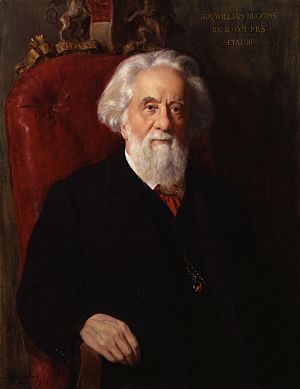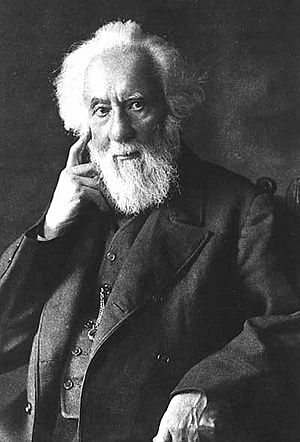William Huggins facts for kids
Quick facts for kids
William Huggins
|
|
|---|---|

Portrait by John Collier, 1905
|
|
| Born | 7 February 1824 |
| Died | 12 May 1910 (aged 86) Tulse Hill, London, England
|
| Known for | Astronomical spectroscopy |
| Spouse(s) | Margaret Lindsay Huggins |
| Awards | Royal Medal (1866) Gold Medal of the Royal Astronomical Society (1867) Lalande Prize (1870) Rumford Medal (1880) Valz Prize (1882) Janssen Medal (1888) Copley Medal (1898) Actonian Prize (1990) Henry Draper Medal (1901) Bruce Medal (1904) |
| Scientific career | |
| Fields | Astronomy |
Sir William Huggins (born February 7, 1824 – died May 12, 1910) was a British astronomer. He is famous for his important work in a field called astronomical spectroscopy. He did this pioneering research with his wife, Margaret Huggins.
Contents
William Huggins' Early Life & Work
William Huggins was born in Cornhill, London, in 1824. He grew up with a strong interest in science. In 1875, he married Margaret Lindsay. She was also very interested in astronomy and scientific research.
Margaret was a great support to William. She encouraged his use of photography in his studies. She also helped him organize their research in a very careful way.
Building a Private Observatory
Huggins built his own private observatory at his home in Tulse Hill, London. From this special place, he and Margaret studied many objects in space. They looked at the light from stars and nebulae.
They used a technique called spectroscopy. This method helps scientists understand what stars and other space objects are made of. It also shows how they are moving.
Discovering What Space Objects Are Made Of
On August 29, 1864, Huggins made a big discovery. He was the first person to study the light spectrum of a planetary nebula. This particular nebula was called NGC 6543.
He also figured out how to tell the difference between nebulae and galaxies. He showed that some nebulae, like the Orion Nebula, are made of gas. Their light spectra looked like glowing gas.
Other objects, like the Andromeda Galaxy, had light spectra like stars. This meant they were made of many stars, not just gas.
Huggins got help with his light analysis from his neighbor. This was a chemist named William Allen Miller. Huggins was also the first to use a new photography method. It was called dry plate photography. This helped him take better pictures of objects in space.
Measuring Star Movement
In 1868, Huggins observed the star Sirius. He noticed something called a redshift in its light. This meant Sirius was moving away from Earth.
Huggins then suggested that scientists could use this redshift. They could calculate how fast a star was moving towards or away from us. This speed is called its radial velocity.
Awards and Recognition
William Huggins received many important awards for his work. He was honored by several scientific groups.
Awards for His Astronomical Work
Huggins won the Gold Medal of the Royal Astronomical Society in 1867. He shared this award with William Allen Miller. He later became the president of this society from 1876 to 1878.
He received the Gold Medal again in 1885, this time by himself. He was an officer of the Royal Astronomical Society for 37 years. This is longer than anyone else.
Awards from the Royal Society
Huggins became a member of the Royal Society in 1865. This is a very old and respected scientific group. He received several medals from them:
- Royal Medal (1866)
- Rumford Medal (1880)
- Copley Medal (1898)
He also gave a special talk called the Bakerian Lecture in 1885. He served as the president of the Royal Society from 1900 to 1905.
William Huggins passed away in 1910 after an operation. He was buried in Golders Green Crematorium.
Telescopes Used by Huggins
William Huggins used several telescopes for his observations.
- In 1856, he got a 5-inch telescope made by Dollond.
- In 1858, he added an 8-inch telescope by Clark.
- Both of these were refracting telescopes. These telescopes use lenses to gather light.
- In 1870, Huggins also set up an 18-inch reflecting telescope. This type of telescope uses mirrors.
Honors and Legacy
William Huggins was recognized for his amazing contributions to science.
Special Titles
- He was made a Knight Commander of the Order of the Bath (KCB) in 1897. This meant he was called "Sir William Huggins."
- He was also one of the first people to receive the Order of Merit (OM) in 1902. This is a very special honor given by the King.
Awards and Memberships
- Royal Medal (1866)
- Lalande Prize (1870)
- Gold Medal of the Royal Astronomical Society (1867, 1885)
- Rumford Medal (1880)
- Valz Prize (1882)
- Member of the Royal Swedish Academy of Sciences (1883)
- Janssen Medal (1888)
- Copley Medal (1898)
- Henry Draper Medal from the National Academy of Sciences (1901)
- Bruce Medal (1904)
Things Named After Him
To honor his work, several things in space were named after William Huggins:
- Huggins (lunar crater) (a crater on the Moon)
- Huggins (Martian crater) (a crater on Mars)
- Asteroid 2635 Huggins (a small rocky body orbiting the Sun)
See also
 In Spanish: William Huggins para niños
In Spanish: William Huggins para niños
- Planetary nebula#Observations
- Timeline of knowledge about the interstellar and intergalactic medium


